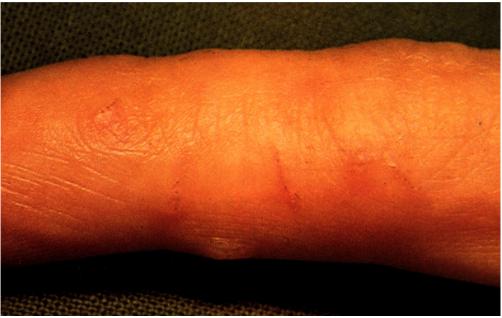Scabies
|
The itching and rash associated with scabies is not due the infestation per se but are the consequence of the body's immune response to the presence of the mite and its waste products. Consider the diagnosis of scabies in any a patient with a smoldering itchy rash with itchy papules on the genitalia, web spaces, or wrists. Some patients will have few if any symptoms with their infestation. While a positive scabies scrape preparation taken from a typical "burrow" is diagnostic, it is frequently negative, even in a "classic" case (figure 7).
While
conceptually simple, the treatment of scabies is sometimes difficult
to execute properly in practice. Do not use Kwell shampoo to treat
scabies...it won't work. Use Kwell cream/lotion or Elimite cream at
bedtime exactly as written in the PDR. Thirty to sixty grams
of the cream or 60-120 ml of lotion should cover the whole body. Be
sure to treat from the neck all the way to the toes being sure to get
every crack and crevice in between. Be sure to apply the medication
to the web spaces, underneath the fingernails, and the genitalia. Do
not wash the hands or fingers before going to sleep. Retreat the patient the
following evening. The itching usually takes a few days to subside.
All scabies medications are somewhat irritating and drying to the
skin. Use bland emollients or if necessary medium potency topical
steroids after the second application is rinsed off to control
residual irritation and dryness. All clothing, underwear
and nightclothes, linen and towels used in the past 2 weeks by the
patient require washing in hot water or dry cleaning. All household
and/or sexual contacts should be treated. Aboard ship or in a
barracks or any other very "close living" situation, persons nearby
should be checked carefully for evidence of infestation. If in doubt,
treat the patient. |
Written and revised by CAPT Dennis A. Vidmar, MC, USN, Department of Military and Emergency Medicine, and Department of Dermatology, Uniformed Services University of the Health Sciences, Bethesda, MD (1999). Additional images provided by CAPT Vidmar in June, 2000, subsequent to the initial publication of this manual. |
Preface · Administrative Section · Clinical Section
The
General Medical Officer Manual , NAVMEDPUB 5134, January 1, 2000
Bureau
of Medicine and Surgery, Department of the Navy, 2300 E Street NW, Washington, D.C.,
20372-5300
This web version of The General Medical Officer Manual, NAVMEDPUB 5134 is provided by The Brookside Associates Medical Education Division. It contains original contents from the official US Navy version, but has been reformatted for web access and includes advertising and links that were not present in the original version. This web version has not been approved by the Department of the Navy or the Department of Defense. The presence of any advertising on these pages does not constitute an endorsement of that product or service by either the Department of Defense or the Brookside Associates. The Brookside Associates is a private organization, not affiliated with the United States Department of Defense. All material in this version is unclassified. This formatting © 2006 Medical Education Division, Brookside Associates, Ltd. All rights reserved.
Home · Textbooks and Manuals · Videos · Lectures · Distance Learning · Training · Operational Safety · Search
|
|
|
This website is dedicated to the development and dissemination of medical information that may be useful to those who practice Operational Medicine. This website is privately-held and not connected to any governmental agency. The views expressed here are those of the authors, and unless otherwise noted, do not necessarily reflect the views of
the Brookside Associates, Ltd., any governmental or private organizations. All writings, discussions, and publications on this website are unclassified.
© 2006 Medical Education Division, Brookside Associates, Ltd. All rights reserved
Other Brookside Products

